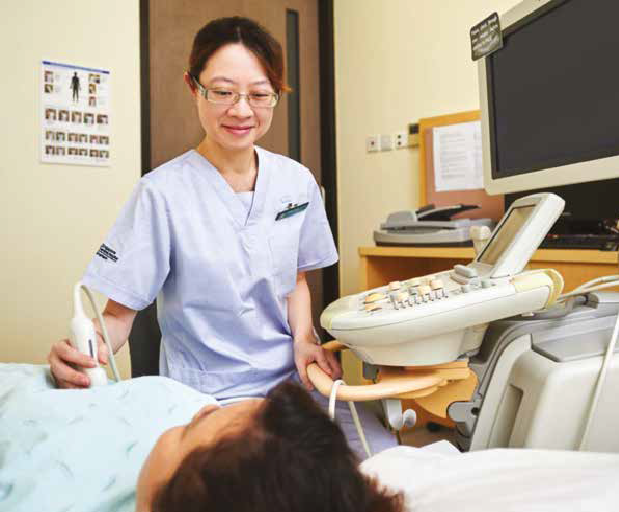
Radiographer Heng Ai Ling loves her job that aids diagnosis, and is constantly looking ways to improve her work to make it safer and better for patients.
When Singapore General Hospital (SGH) opened an off-site radiography clinic in 2012, Senior Principal Radiographer Heng Ai Ling was put in charge. It was in the Camden Medical Centre, tucked away in a leafy and secluded corner of the Tanglin area.
It was there that Ms Heng developed an interest in improvement projects.
“Being a new service centre, the satellite clinic offered many opportunities for improvement. We had patients who did not know how to get to Camden and were frequently late for their appointments. So my first project was to create a map with directions so that they were able to locate the centre correctly,” said Ms Heng.
Today — and many winning projects later — Ms Heng leads colleagues at the Division of Radiological Sciences in quality innovation (QI), an area that hospital staff are encouraged to take part in to improve protocols and patient safety, and reduce waste. For instance, she is currently working on developing an ultraviolet chamber to disinfect a positioning aid used to keep patients still while undergoing x-ray scans. This would allow more patients to be quickly and safely scanned during the COVID-19 pandemic.
Her interest in this area might have stemmed from a desire “to be at the forefront of using medical equipment to help diagnose patients’ conditions”. Ms Heng joined SGH’s Department of Diagnostic Radiology after getting her Diploma in Radiography from Nanyang Polytechnic in 1998.
“As a radiographer, you learn how to produce images that aid in the diagnosis of a patient. It is especially rewarding when the diagnosis that you helped with leads to proper treatment for the patient,” she said.
Ultrasound scans, which Ms Heng specialises in, are important during the pandemic to detect deep vein thrombosis, which is common among COVID-19 patients.
For her efforts in improvement projects, Ms Heng was given the opportunity to present at overseas conferences. In Madrid, she presented her research on reducing patients’ fasting time before their gall bladder and renal arteries ultrasound scans. From the findings, the department has cut the fasting time from seven hours to five.
Ms Heng also co-authored a study on how the pandemic affected her peers. It led to two initiatives, Braveheart and Peers at Work, for staff to express or share their feelings and thoughts during this pandemic.
“It is like a communications session to to voice out areas of concern to the management. At radiography, we also promoted Joy at Work, for staff to send their colleagues handwritten notes of appreciation and support,” said Ms Heng.
As a Malaysian, she understands the needs and worries of her fellow foreign colleagues at this time. Her parents used to visit her from Johor frequently, but they have not seen each other since the pandemic started. However, her husband, two sisters and their husbands are here. Coincidentally, they are also healthcare workers in other Singapore hospitals.
Ms Heng is also a keen researcher and sits on her division’s serious reportable events committee. Work on the latter is especially time-consuming, she said, as she has to trawl through different statistics to look for trends and causes of incidents. “I usually do these in my own time. I set short-term priorities and do one thing at a time,” she added.
She hopes for more opportunities to work with other colleagues within the SingHealth family. “In QI, we work on projects to improve our own department. But other hospitals may be working on similar projects or are already doing a good job in that area, so if we can standardise best practices, that would be good,” she said.
To recharge, the Japanophile used to visit the land of the rising sun at least twice every year. With the pandemic, however, she has had to be content with eating her favourite sushi and other Japanese food in Singapore.
“I love the Japanese culture. Their omotenashi service standards translate to ‘every service is from the bottom of the heart’, and this is similar to SingHealth’s mission of ‘Patients at the Heart of All We Do’,” said Ms Heng.
Get the latest updates about Singapore Health in your mailbox! Click here to subscribe.













 Get it on Google Play
Get it on Google Play